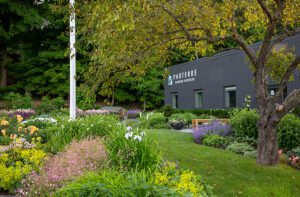As the Wheel Turns
May 10, 2011
Text by Christine Temin
“People say you are what you eat. I think it’s that you are what you eat on.” The man who utters that slightly skewed version of the old adage is ceramic artist Mark Shapiro, who lives and works in Worthington, Massachusetts, at Stonepool Pottery, his home, studio and gallery. The rustic, rambling buildings, which date from the end of the eighteenth century and into the nineteenth, sit among acres of tranquil forest in the Pioneer Valley. When Shapiro moved here in 1986, the place was, he says, “a shipwreck.”
The name Stonepool comes from an actual stone pool—a big, round drainage system—on the land. “It’s like a pot,” Shapiro says, “just larger.”
He loves this place, where he, his wife and their two children live in a house cozily heated by wood stoves, with hundreds of pieces of pottery occupying cupboards, the mantel and just about any other flat surface. Even the toothbrush holder in a bathroom is made of clay. The artist collects eighteenth- and nineteenth-century New England pots, admiring their swelling, ovoid forms and their usefulness as containers for foods that were pickled or salted.
He also loves history, particularly the story of Stonepool, where the preacher, orator, abolitionist and Temple University founder Russell Conwell was born in 1843. Sources say that the farmhouse was part of the Underground Railroad, and among its guests were John Brown and Frederick Douglass. Fugitive slaves once stayed in the shed that Shapiro turned into his gallery.
Many of the old pots he so admires sit high on a shelf in his studio, watching over his more contemporary efforts. There is much to admire about his own work, as well. A table in the studio holds a lineup of oversize mugs that have been coated in wax. The artist digs into the wax to form little vertical trenches that he colors in with quick, expert gestures; it takes him but a few minutes to paint each piece. Those sputtering marks suggest calligraphy or action painting by the likes of Jackson Pollock. Elsewhere on the capacious table sits a group of large six-sided jars. He slices into their surfaces with a knife and creates hexagons that travel around the pieces with sculptural results.
Most of Shapiro’s work is meant to be eaten on, drunk from or otherwise used. Lately, though, he’s been creating large, slender, bottle-shaped pieces just to look at. “I love the scale,” he says of the works, which, at up to five feet tall, have an almost human presence.
Although Shapiro owns an electric wheel and kiln, he generally favors more traditional means like his treadle wheel, which he operates while seated. He rocks the treadle with his feet to move the wheel, shaping the pot with his hands. “I like having both the lower and upper parts of my body engaged,” he says. And he notes that one reason he left New York’s Staten Island to move up country was to build his two wood-fired kilns.
Shapiro graduated from Amherst College before studying pottery at North Carolina’s Penland School, a leading center for craft. An idealist with a back-to-the-land ethos, he seems to be made for the town he calls home. “At one time I wanted to be the town potter,” he says.
He still loves connecting with the locals. “This guy who lives in Worthington came and stayed here for two hours,” he says with pleasure. The visitor, a state policeman, ultimately bought four mugs.
Some artists want to talk about themselves more than anything else, but not Shapiro. “It’s much more interesting to talk about other potters than about myself,” he says. So he introduces his current apprentice, Jeffrey Lipton, before saying a word about himself, and then detours to talk about the eighty-five-year-old potter Karen Karnes. He’s just edited A Chosen Path: The Ceramic Art of Karen Karnes, a book that accompanies a touring exhibition of the distinguished potter’s work.
In his foreword, he reminisces about being a ceramics-obsessed teenager growing up in Manhattan. He happened on a show of Karnes’s art and bought the smallest piece in the exhibition. “It cost $14,” he writes, “a dollar for every year of my life.”
While Shapiro says his style has probably been more strongly influenced by potters like Michael Simon, the Georgia artist who tends to push the boundaries of the functional form, he counts Karnes as a profound influence on his attitude about his work. “She has lived her life with such integrity and courage and stayed so true to her vision,” he says. “The reward for doing this work is doing the work. If the reward isn’t enough, you should do something else.”
EDITOR’S NOTE Mark Shapiro is represented by the Ferrin Gallery in Pittsfield, Mass., (413) 442-1622, www.ferringallery.com, and the Lacoste Gallery in Concord, Mass., (978) 369-0278, www.lacostegallery.com. His work can also be seen by appointment at the Stonepool gallery, (413) 238-5362.
Share
![NEH-Logo_Black[1] NEH-Logo_Black[1]](https://b2915716.smushcdn.com/2915716/wp-content/uploads/2022/08/NEH-Logo_Black1-300x162.jpg?lossy=1&strip=1&webp=1)



















You must be logged in to post a comment.